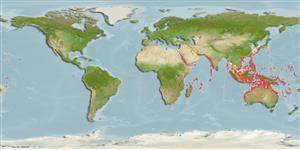Environment: milieu / climate zone / depth range / distribution range
Ekologi
laut berasosiasi dengan karang; kisaran kedalaman 0 - 55 m (Ref. 26165), usually 5 - 35 m (Ref. 27115). Tropical; 22°C - 28°C (Ref. 27115); 35°N - 36°S, 24°E - 169°W
Indo-West Pacific: Red Sea and Natal, South Africa to Niue (Ref. 37816), north to Japan, south to Australia. Recorded from Europa Island (MNHN 1992-0508).
Size / Weight / umur
Maturity: Lm ? range ? - ? cm
Max length : 15.0 cm TL jantan/; (Ref. 9710); 7.0 cm TL (female)
Duri punggung (Keseluruhan (total)): 10; duri punggung lunak (Keseluruhan (total)): 15-17; Duri dubur 3; Sirip dubur lunak: 6 - 7. Color patterns vary from one locality to another.
Adults are found above coral outcrops or patch reefs of clear lagoons, channels, or outer reef slopes. Form large aggregations. Feed on zooplankton (Ref. 6113). A protogynous hermaphrodite (Ref. 55367). Males are territorial and haremic (Ref. 9710). Color patterns and size of sexual transition very slightly from one locality to the next. Total length for females from Ref. 9137.
Life cycle and mating behavior
Kematangan | Reproduksi, perkembang biakan | Pemijahan | telur-telur | Fecundity | Larva
Pelagic spawner. A monandric species (Ref. 55367). Females are induced to change sex by removal of males from social groups (Ref. 38802). Sex-reversal is completed in 2-4 weeks after male removal in the area, or 170-280 days in an all female group (Ref. 34185, 34249, 34250). Length at sex change = 5.0 cm TL (Ref. 55367). Also Ref. 103751.
Successful males spawn nightly with successive females (Ref. 37816).
Randall, J.E., G.R. Allen and R.C. Steene, 1990. Fishes of the Great Barrier Reef and Coral Sea. University of Hawaii Press, Honolulu, Hawaii. 506 p. (Ref. 2334)
Status IUCN Red List (Ref. 130435)
ancaman kepada manusia
Harmless
penggunaan manusia
Perikanan: nilai komersial kecil; Akuarium: Komersial
informasi lanjut
AcuanBudidaya airprofil budidaya airStrainGenetikaElectrophoresesDiturunkanPenyakit-penyakitPengolahanNutrientsMass conversion
Alat, peralatan
laporan khas
muat turun XML
Sumber internet
Estimates based on models
Preferred temperature (Ref.
123201): 24.3 - 28.9, mean 27.6 °C (based on 1000 cells).
Phylogenetic diversity index (Ref.
82804): PD
50 = 0.5000 [Uniqueness, from 0.5 = low to 2.0 = high].
Trophic level (Ref.
69278): 3.4 ±0.45 se; based on food items.
Generation time: 1.8 ( na - na) years. Estimated as median ln(3)/K based on 1
growth studies.
Daya lenting (Ref.
120179): Tinggi, Waktu penggandaan populasi minimum kurang dari 15 bulan (K=0.6).
Fishing Vulnerability (Ref.
59153): Low vulnerability (23 of 100).
Nutrients (Ref.
124155): Calcium = 83.1 [47.1, 158.8] mg/100g; Iron = 0.796 [0.436, 1.349] mg/100g; Protein = 18 [16, 20] %; Omega3 = 0.167 [0.104, 0.269] g/100g; Selenium = 26.4 [15.1, 50.7] μg/100g; VitaminA = 207 [72, 672] μg/100g; Zinc = 1.48 [0.99, 2.13] mg/100g (wet weight);
